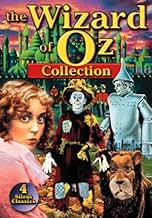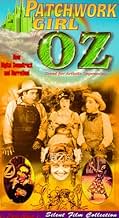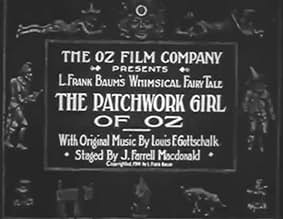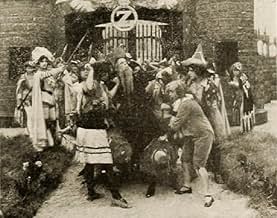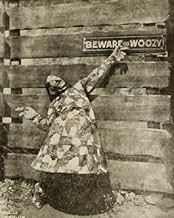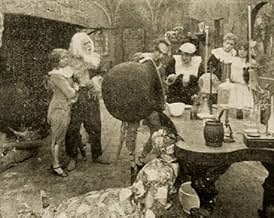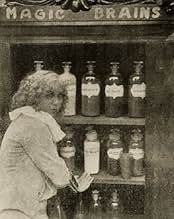Ojo y Unc Nunkie se han quedado sin comida, por lo que deciden viajar a la Ciudad Esmeralda, donde nunca morirán de hambre.Ojo y Unc Nunkie se han quedado sin comida, por lo que deciden viajar a la Ciudad Esmeralda, donde nunca morirán de hambre.Ojo y Unc Nunkie se han quedado sin comida, por lo que deciden viajar a la Ciudad Esmeralda, donde nunca morirán de hambre.
Leontine Dranet
- Margolotte, his wife, who makes the Patchwork Girl
- (as Haras Dranet)
Richard Rosson
- Danx, a Noble Munchkin
- (as Dick Rosson)
Bert Glennon
- The Scarecrow
- (as Herbert Glennon)
Hal Roach
- The Cowardly Lion
- (as Al Roach)
- …
Dave Anderson
- The Hungry Tiger
- (as Andy Anderson)
Pierre Couderc
- Scraps, the Patchwork Girl
- (as The Marvelous Couderc)
Opiniones destacadas
L. Frank Baum himself produced and wrote this adaptation of his own Oz book, a full quarter century before Judy Garland strolled the yellow brick road. What survives is an intriguing artifact from cinema's infancy, antiquated in style and naive in sentiment, but compensating with plenty of charm for what it lacks in sophistication. The influence of theater can still be seen in the histrionic acting and static camera set-ups, but the affection Baum lavished on his creations (munchkins, magicians, 'hoppers', the 'woozy') is clearly evident, even today. His fertile imagination, reinforced by some clever (if primitive) camera tricks, makes this an enchanting fantasy with more than merely academic interest for students of early film history.
A feast of quaint but super-hectic activity, presented before a solidly stationary camera (except for the effective concluding shot), this is a dated and none too interesting attempt by author L. Frank Baum himself to transfer his Oz from the printed page to the cinema. He is let down by the totally unimaginative direction (from well-known character actor J. Farrell MacDonald), the almost entirely stationary camera-work (though there are a couple of clever touches here and there) with its long, boring takes, and the inappropriately over-the-top enthusiasm of almost all the players.
As a curiosity, the movie would make a tolerable two-reeler, but 65 minutes of repetitious jumping, sliding, running, kicking, dancing, climbing, gallivanting, funning and frolicking, is, despite the picturebook tints and novel costumes of its picturebook illustrations brought to life, just far too much of a mediocre thing.
Now, if the highly imaginative original drawings by W.W. Denslow that accompanied Baum's first and most famous venture into the land of Oz, The Wonderful Wizard of Oz (1900), had been brought to life rather than the conventional Victoriana here displayed, the film would doubtless have captured an audience's interest far more than this ultimately wearisome parade. Unfortunately, there was no chance of that happy eventuality. Baum and Denslow had a falling out in 1901 when both men claimed that the instant success of Oz was primarily due to their own input. Therefore it's no surprise that producer Baum made it his business to ensure the movie's visuals were as far removed from Denslow's creations as possible.
As a curiosity, the movie would make a tolerable two-reeler, but 65 minutes of repetitious jumping, sliding, running, kicking, dancing, climbing, gallivanting, funning and frolicking, is, despite the picturebook tints and novel costumes of its picturebook illustrations brought to life, just far too much of a mediocre thing.
Now, if the highly imaginative original drawings by W.W. Denslow that accompanied Baum's first and most famous venture into the land of Oz, The Wonderful Wizard of Oz (1900), had been brought to life rather than the conventional Victoriana here displayed, the film would doubtless have captured an audience's interest far more than this ultimately wearisome parade. Unfortunately, there was no chance of that happy eventuality. Baum and Denslow had a falling out in 1901 when both men claimed that the instant success of Oz was primarily due to their own input. Therefore it's no surprise that producer Baum made it his business to ensure the movie's visuals were as far removed from Denslow's creations as possible.
Quite an enjoyable movie. I'd seen it twice before (in the Origins of Film box set), and watched it again with my grandmother who was born the year it was released. L. Frank Baum produced, and was evidently on the set with the director.
A young boy named Ojo (played by a woman) lives with his Unc Nunkie, and they've run out of food. They decide to go to Oz, where there is always more than enough food.
On the way, they encounter a wizard who's been working on a potion for six years to create life. His wife, using a magic wand, assembles a human-size patchwork doll to use the potion on. It won't have brains, since that makes for better servants says the wife. Ojo decides to mix up some magic brains and surreptitiously put them in, however. After the Patchwork Girl (played by a man) is brought to life, there's an accident that results in the wizard's wife, Unc Nunkie, and the Munchkin lover of the wizard's daughter being petrified. Munchkins in this film are not little people, though they do wear different costumes.
Ojo, the Patchwork Girl, the wizard, his daughter and her friends must go out to collect ingredients for an antidote: three hairs from a Woozy's tail, a six-leaved clover, and a gill of water from a Dark Well. The daughter has her father shrink her petrified boyfriend down to doll size, since she can't be without him.
On the way, they meet one-legged Hoppers, tribal Tottenhots, and jolly Horners. They encounter a maid of Oz who helps them, but who also develops a liking for the petrified Munchkin.
The sets are simple, yet nicely establish a fantasy world. Costumes are good too. The wizard character is stooped and knock-kneed (possibly from stirring a potion for six years with his hands *and* legs?). The Woozy is neat, a big boxy cat played by Fred Woodward, who specialized in animal roles (he does several others in this movie). Despite being a simple costume, it seems more real than some CGI creations.
The Wizard of Oz, the Tin Man, the Scarecrow, and the Cowardly Lion show up towards the end. The original mission to obtain food is forgotten by that point!
It's a cute movie, and I suspect that despite being silent (with musical score added) and black and white, and ninety-one years old that it would still delight small children.
A young boy named Ojo (played by a woman) lives with his Unc Nunkie, and they've run out of food. They decide to go to Oz, where there is always more than enough food.
On the way, they encounter a wizard who's been working on a potion for six years to create life. His wife, using a magic wand, assembles a human-size patchwork doll to use the potion on. It won't have brains, since that makes for better servants says the wife. Ojo decides to mix up some magic brains and surreptitiously put them in, however. After the Patchwork Girl (played by a man) is brought to life, there's an accident that results in the wizard's wife, Unc Nunkie, and the Munchkin lover of the wizard's daughter being petrified. Munchkins in this film are not little people, though they do wear different costumes.
Ojo, the Patchwork Girl, the wizard, his daughter and her friends must go out to collect ingredients for an antidote: three hairs from a Woozy's tail, a six-leaved clover, and a gill of water from a Dark Well. The daughter has her father shrink her petrified boyfriend down to doll size, since she can't be without him.
On the way, they meet one-legged Hoppers, tribal Tottenhots, and jolly Horners. They encounter a maid of Oz who helps them, but who also develops a liking for the petrified Munchkin.
The sets are simple, yet nicely establish a fantasy world. Costumes are good too. The wizard character is stooped and knock-kneed (possibly from stirring a potion for six years with his hands *and* legs?). The Woozy is neat, a big boxy cat played by Fred Woodward, who specialized in animal roles (he does several others in this movie). Despite being a simple costume, it seems more real than some CGI creations.
The Wizard of Oz, the Tin Man, the Scarecrow, and the Cowardly Lion show up towards the end. The original mission to obtain food is forgotten by that point!
It's a cute movie, and I suspect that despite being silent (with musical score added) and black and white, and ninety-one years old that it would still delight small children.
You really have to look at "The Patchwork Girl of Oz" in context, otherwise you'll just dismiss it as a dull and incomprehensible movie. But, back in 1914, it was a rather impressive tale--but one that even audiences back then probably struggled to understand unless they'd read the Frank Baum story. Heck, I tried watching it was was TOTALLY confused until I read a summary of the story on the internet! That's because the narrative is really scant--with almost no intertitle cards. Instead, it's shown as a series of tenuously connected vignettes which are described on the card and then acted out...as was the style up until about 1914 or a bit later. It comes off almost like a slide show that is acted out for the audience! This certainly is NOT all that entertaining and too often the characters just cavort about aimlessly or do acrobatics instead of acting--and it comes off pretty poorly. BUT, again, it was pretty much the style of the day. The ladies in the film and sets and 'magic' were pretty similar to the work done a decade earlier by the groundbreaking French film maker Georges Méliès. By 1914, these amazing effects and story telling really were a a bit passé--definitely on their way out--which might explain why the film was a critical flop--that, and the fact that the audience probably had no idea what was occurring on screen! Interesting from a historical perspective and having excellent production values for the time, but still very easy to skip unless you adore very early silent films.
As a child, The Patchwork Girl of Oz was my favorite Oz book. This silent film version is a charming look at how Oz was envisioned by it's creator--L. Frank Baum produced the film. The story however does stray from the book and some of the scenes are a bit disjointed. Motion pictures were in their infancy in 1914--most films were stagebound dramas, so to see a fantasy film from this period is unique.
The Patchwork Girl or "Scraps" is played by French acrobat Pierre Couderc. The part where Scraps catches the eye of the Scarecrow is very amusing. Also, the Yoop character is a forerunner to the Winged Monkeys who terrorized Judy Garland 25 years later.
In the video version I saw, the pivotal scene where Scraps is brought to life and tips over the Liquid of Petrification, is missing or destroyed--but the rest of the film is intact however.
The Patchwork Girl or "Scraps" is played by French acrobat Pierre Couderc. The part where Scraps catches the eye of the Scarecrow is very amusing. Also, the Yoop character is a forerunner to the Winged Monkeys who terrorized Judy Garland 25 years later.
In the video version I saw, the pivotal scene where Scraps is brought to life and tips over the Liquid of Petrification, is missing or destroyed--but the rest of the film is intact however.
¿Sabías que…?
- TriviaHarold Lloyd and Hal Roach, who both have minor roles in this film, met on this set in San Diego. Roach was impressed by Lloyd's energy and sought him out when he formed his production company The Rolin Film Company in July 1914 after receiving a small inheritance. Although their association was stormy, their association was ultimately one of the most successful in silent film history.
- ErroresThe character of Ojo is stated several times to be a boy, but is referred to as a girl in one of the dialogue caption cards.
- ConexionesFeatured in American Masters: Harold Lloyd: The Third Genius (1989)
Selecciones populares
Inicia sesión para calificar y agrega a la lista de videos para obtener recomendaciones personalizadas
- How long is The Patchwork Girl of Oz?Con tecnología de Alexa
Detalles
- Tiempo de ejecución1 hora 21 minutos
- Color
- Mezcla de sonido
- Relación de aspecto
- 1.33 : 1
Contribuir a esta página
Sugiere una edición o agrega el contenido que falta

